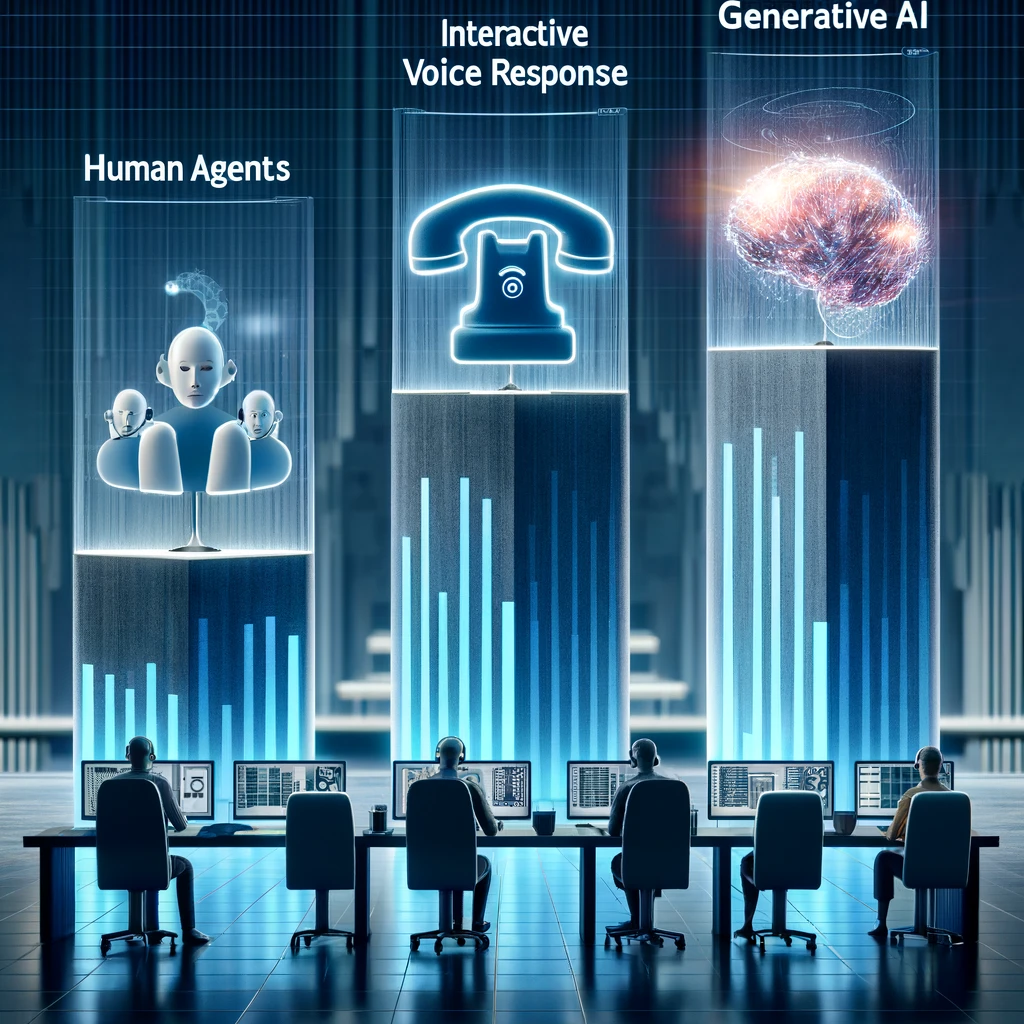When it comes to handling customer contact, you have choices: Humans, Legacy IVR / NLU, and Generative AI.
Which is right for your business, your customers, and your use case?
The most obvious and objective way to look at this is through the lens of the cost per contact. If we make a bunch of assumptions, do the math, and plot the equivalent cost per contact vs contact volume, we get this little beauty:

Agents are about the same cost whatever the volume. That’s the red line in the chart above. I’ve kept things simple, with the average handling time (AHT) at 5 minutes, and the human agents costs $1 per minute – a little bit above North American averages, but it keeps the numbers simple. I’m assuming that includes hiring, training, management, infrastructure, and a realistic utilization level is factored in.
For IVR and NLU, it’s more like 6c per minute. That’s what Google charges for their Dialogflow platform.
For generative AI powered voice bots, it seems the market consensus is around 12c per minute.
Dialogflow wins, right? 5c vs one dollar is a no brainer, surely?
Not so fast. The deployment and ongoing monitoring/optimization costs vary significantly between IVR/NLU and generative AI, if you do it right!
Now there are plenty of people that’ll offer to deploy your IVR (or Google Dialogflow app) for next to nothing. But that’s part of the reason there are so many bad experiences out there. Done right, a decent Dialogflow deployment is going to cost you around $250k. It’ll go up from there (but not down much) depending on the use case and complexity. Let’s peg the ongoing services at 20%… a de-facto standard for IT deployments that most procurement departments won’t blink at. So that’s $50k a year, once in production.
For generative AI, the dynamics are different. It’s more expensive per minute. And because it ‘generates’ responses, rather than designers and developers hand-coding everything, it’s faster and cheaper to deploy. The market is still figuring out what it really costs, but we’re looking at around $150k. Once deployed, you need to watch those voice bots very carefully, and you’ll want to constantly optimize the prompts, data, and knowledge sources to keep it out of trouble, and delivering value. There’s literally no one I’m aware of with a voice bot in production for a year, so we’re guessing a bit here, but I’m going to peg it at 100% of deployment costs. So that’s $150k per year, once in production.
For humans, that $1 per minute covers hiring, training, and management, the equivalent of ‘deployment’ and ‘optimization’, so nothing to add there.
We also need to consider how good IVR/NLU and generative AI powered voice bots are. In spite of what your deceptive containment reports say, your IVR is not going to handle every contact you send to it. Not even close. I’ve assumed 75%, which is still quite toppy.
For generative AI done right we can expect much better success. Generative AI is much more robust. It’s more like a junior agent than IVR. I’ve gone for 90% success rate.
The chart above models how this plays out over a 2-year period. The vertical axis is the equivalent cost per contact, after we’ve allowed for the setup, optimization, and usage costs. The horizontal axis considers the volume of contact handled each year.
For low volumes, humans win. But as the volume goes up, the equivalent costs of generative AI and IVR/NLU goes down.
Beyond 40k contacts per year, a well deployed IVR/NLU use case starts to get cheaper than humans.
Same happens for generative AI a bit later.. around 55k contacts.
But remember, this is – roughly – per use case. If you’ve got a million calls per year, you’ll need 4% of them handled by a single IVR use case or 5.5% handled by a generative Ai use case, before it makes sense, based solely on the cost-per-contact metric.
Further out to the right, the cost per contact of IVR is generative AI actually becomes much closer: about 90c per contact for generative AI, 70c for IVR/NLU. It’s not ‘twice the price’ as a casual comparison of Dialogflow and generative AI powered voice bot pricing might suggest.
What does this mean? Let’s boil it down to a few simple principles:
- IVR is more expensive up front, but cheaper in the long run than generative AI powered voice bots, as long as your IVR is done really well. Usually it’s not.
- Generative AI is cheaper up-front, and more expensive in the long run, but the difference isn’t as big as you’d think, because generative AI is cheaper to set up, and performs better.
- With generative AI, you need around 50k contacts per year to break even vs human agents.
This analysis is most relevant when you’re considering whether to build a new use-case with IVR/NLU, or generative AI. But if you’ve already got a bunch of decent IVRs, you’ll find it hard to justify moving to generative AI, because you’ve already incurred the big up-front cost. So don’t. Sweat your existing IVR apps and build new generative AI apps that focus on use-cases where IVRs struggle.
Kerry
PS: You are building with genAI right now, aren’t you? If not, what’s stopping you? Check out our latest blog on gen-AI blockers, or sign up for a complimentary Strategy Workshop to help you get started.
PPS: If you want a more regular dose of insights, subscribe to our weekly email that’ll make you think differently about your IVR, voice, and chatbots.
About the Author

Kerry Robinson
VP of AI Strategy
Waterfield Tech
An Oxford physicist with a Master’s in Artificial Intelligence, Kerry is a technologist, scientist, and lover of data with over 20 years of experience in conversational AI. He combines business, customer experience, and technical expertise to deliver IVR, voice, and chatbot strategy and keep Waterfield Tech buzzing.


